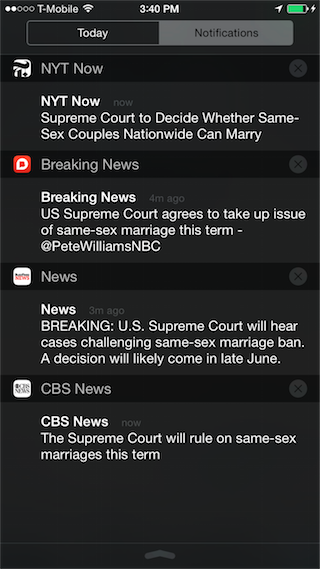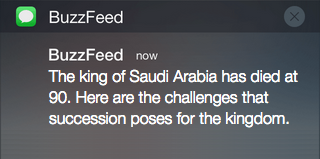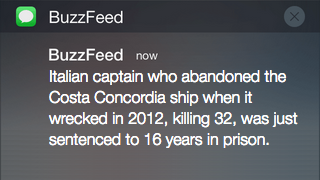We've kept one main goal in mind as we experiment with push notifications in our early alpha testing of the BuzzFeed News app (launching for iOS this summer!): deliver useful breaking news — with context.
What that goal doesn't include is a mission to always be the first to break news with our notifications, or to drive clicks to BuzzFeed.com. That frees us up to think about how to write an alert that can provide real value to our audiences.
It also means our alerts have been a little longer than most, which allows us to be clear and explanatory, a topic I've written about for Poynter in the context of breaking-news tweets.
Here are some examples of how we’ve been delivering breaking news with context to our early internal app testers.
When the U.S. Supreme Court announced it would hear cases about same-sex marriage, we took an extra minute or two to find information that would be useful to readers. We didn't drag our feet, but we also weren't compelled to rush it out. That allowed us to provide a little more context within the news alert itself — without being long-winded:

Here's another example of how we added an extra piece of information to an alert without using an overwhelming amount of characters (this one has 109):

The second sentence provides some social currency: Not only can you lean over to your friend and say, "did you hear about Jon Stewart?" but you can also drop knowledge about the length of his hosting tenure without relying on Siri or Google Now. We tried to anticipate the follow-up factoid readers would want to seek out.
As my colleague Laura Davis explains in another blog post, we want the BuzzFeed News app to be a friend who "always has something interesting to say" and "doesn't confuse you when talking about something important."
(A note on push notification length: We've found that using no more than 120 characters generally keeps alert copy from truncating on most iPhones. The iPhone 6 Plus can easily handle 140 or more, but we're mindful of our readers who haven't upgraded in a few years and thus have smaller phones. Happily, you can still do a lot with 120 characters.)
Sometimes, when a story is complicated or falls under a topic our readers are unlikely to be very familiar with, providing context is hard to do within the text of the alert.
Landing on a breaking news post that doesn't contain much information beyond what the alert itself said isn't a great experience. In news there's a bias to the "new", but we've linked to older pieces when useful.
So when Saudi Arabia's King Abdullah died, we directed readers to a months-old story from the BBC that did a really good — and mobile-friendly! — job of explaining the challenges Saudi Arabia would face:

We don't want to assume lots of prior knowledge about a news story, but we don't want to presume ignorance, either. It's easy to recognize the name of something that was in the news a long time ago without recalling the details.
So we took some extra characters here to remind readers of a few things about the Costa Concordia disaster and why it was such a big deal:

Of course, we're not sure these assumptions are all correct, so we'll be testing other ideas and listening closely to feedback.
We think news alerts can go beyond regurgitating headlines — and do more for readers than compel them to click through to a story because the alert didn't provide all the information it could have in the first place.
